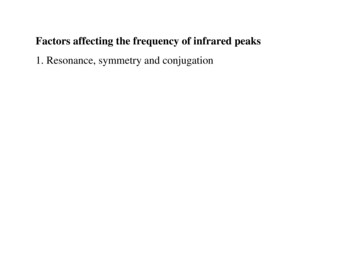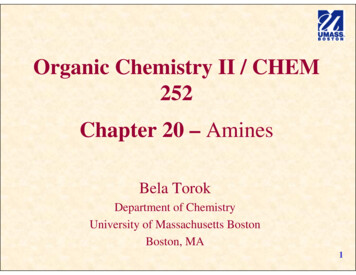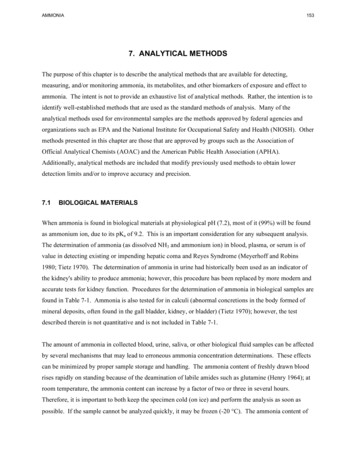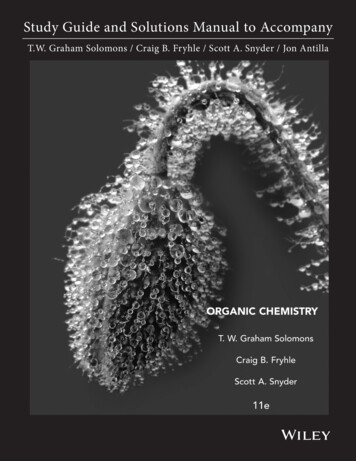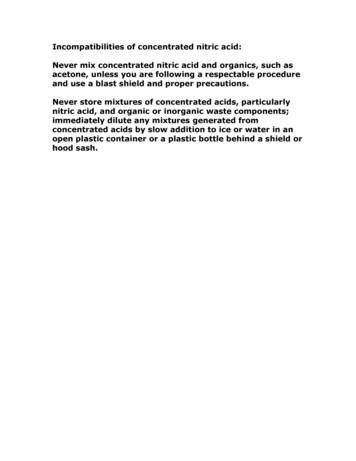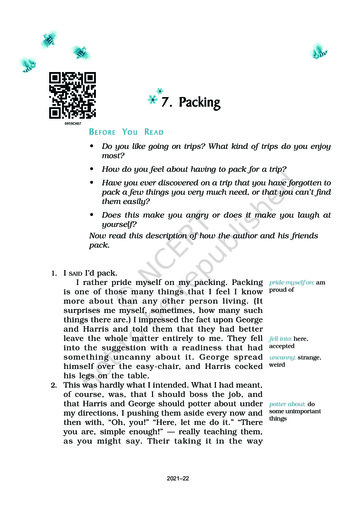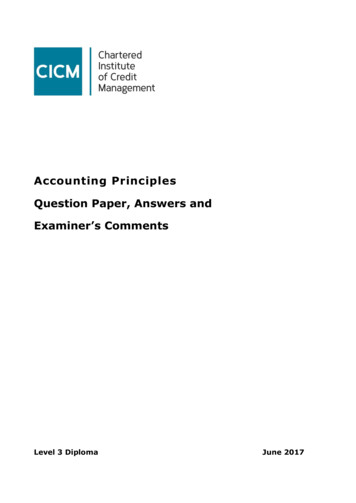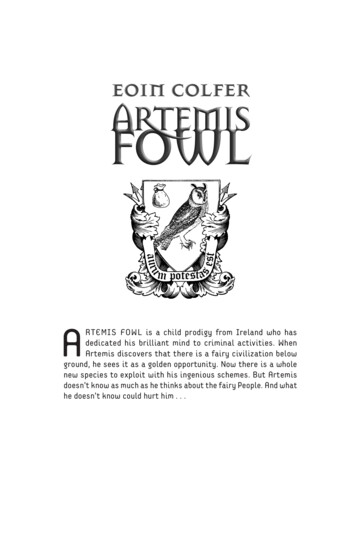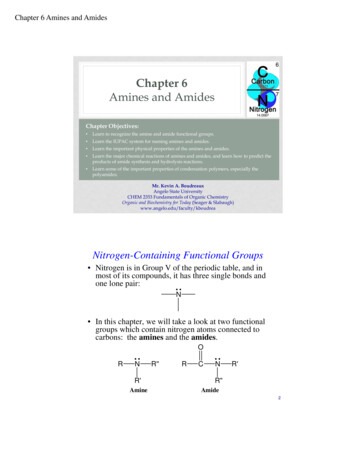
Transcription
Chapter 6 Amines and AmidesChapter 6Amines and AmidesChapter Objectives: Learn to recognize the amine and amide functional groups. Learn the IUPAC system for naming amines and amides. Learn the important physical properties of the amines and amides. Learn the major chemical reactions of amines and amides, and learn how to predict theproducts of amide synthesis and hydrolysis reactions. Learn some of the important properties of condensation polymers, especially thepolyamides.Mr. Kevin A. BoudreauxAngelo State UniversityCHEM 2353 Fundamentals of Organic ChemistryOrganic and Biochemistry for Today (Seager & ontaining Functional Groups Nitrogen is in Group V of the periodic table, and inmost of its compounds, it has three single bonds andone lone pair:N In this chapter, we will take a look at two functionalgroups which contain nitrogen atoms connected tocarbons: the amines and the amides.ORNR'AmineR''RCNR'R"Amide2
Chapter 6 Amines and AmidesClassification andNomenclature of Amines3Amines Amines and amides are abundant in nature. Theyare a major component of proteins and enzymes,nucleic acids, alkaloid drugs, etc. (Alkaloids are Ncontaining, weakly basic organic compounds;thousands of these substances are known.) Amines are organic derivatives of ammonia, NH3, inwhich one or more of the three H’s is replaced by acarbon group. Amines are classified as primary (1 ), secondary(2 ), or tertiary (3 ), depending on how manycarbon groups are connected to the nitrogen atom.HNHRNHRNHRNHHR'R'Ammonia1 Amine2 Amine3 AmineR''4
Chapter 6 Amines and AmidesExamples: Classifying Amines Classify the following amines as primary (1 ),secondary (2 ), or tertiary (3 HN5Nomenclature of Amines Simple 1 , 2 , and 3 amines: common (trivial)names are obtained by alphabetically arranging thenames of the alkyl substituents on the nitrogen andadding the suffix -amine (e.g., ethylmethylamine). Amines in the IUPAC system: the “e” ending ofthe alkane name for the longest chain is replacedwith –amine. The amine group is located by theposition number. Groups that are attached to thenitrogen atom are located using “N” as the positionnumber. More complex primary amines are namedwith —NH2 as the amino substituent. Aromatic amines: named as derivatives of theparent compound aniline. Substituents attached tothe nitrogen are indicated by using “N-” as thelocation number.NH2aniline 6
Chapter 6 Amines and AmidesExamples: Nomenclature of Amines Provide common names for the following 2 and 3 amines; for 1 amines, provide common and/orIUPAC names where mples: Nomenclature of Amines Provide common names for the following 2 and 3 amines; for 1 amines, provide common and/orIUPAC names where possible.CH3NH2CH3CH2CH2CHCH3NH CH3CH3CH2CH2CHCH3CH3NCH3CH3CHCH2CH2NH2NH28
Chapter 6 Amines and AmidesExamples: Nomenclature of Amines Provide common names for the following 2 and 3 amines; for 1 amines, provide common and/orIUPAC names where possible.OHONH2NH2CH3CCH2CH2CH2CHCH39Examples: Nomenclature of Amines Provide names for the following aromatic amines.NH2NH CH3CH3CH3NCH3CH3NCH2CH310
Chapter 6 Amines and AmidesExamples: Nomenclature of Amines Provide names for the following aromatic ples: Nomenclature of Amines Draw structural formulas for the following molecules:– ethylisopropylamine– tert-butylamine– 2-pentanamine12
Chapter 6 Amines and AmidesExamples: Nomenclature of Amines Draw structural formulas for the following molecules:– N-methyl-2-propanamine– 1,6-diaminohexane– 3-amino-1-propanol13Examples: Nomenclature of Amines Draw structural formulas for the following molecules:– N-methyl-2-chloroaniline– N,3-diethylaniline– N,N-dimethylaniline14
Chapter 6 Amines and AmidesPhysical Properties ofAmines15Physical Properties of Amines: H-Bonding 1 and 2 amines can hydrogen bond to each other:CH3NHHCH3NHCH3HHHNCH3NHCH3HNCH3HCH3NCH3CH3 3 amines cannot hydrogen bond to each other:CH3NCH3CH3CH3XCH3NCH3CH3 X NCH3CH316
Chapter 6 Amines and AmidesPhysical Properties of Amines: Boiling Points Nitrogen is less electronegative than oxygen, so theN—H bond is not quite as polar as the O—H bond.– Hydrogen bonds from N—H’s are not as strongas those resulting from O—H’s.– Hydrogen bonding between 1 and 2 amines isnot as strong as those found in alcohols orcarboxylic acids. 1 and 2 amines have lower boiling points thanalcohols of similar molecular weight. 3 amines, since they do not hydrogen bond to eachother, have boiling points similar to hydrocarbons ofthe same molecular weight.17Physical Properties of Amines: Boiling PointsBoiling Point:Carboxylic acidAlcohols1 /2 Amines3 Amines/AlkanesNameMolecular BoilingweightpointAcetic acid60.0 g/mol 118 C1-propanol60.1 g/mol 97 Cpropyl amine59.1 g/mol 48 Cethylmethylamine 59.1 g/mol 36 Ctrimethylamine59.1 g/mol 2.9 Cbutane58.1 g/mol -0.5 C18
Chapter 6 Amines and AmidesPhysical Properties of Amines: Water Solubility 1 , 2 , and 3 amines can all form hydrogen bondswith water. Low-molecular weight amines are generally H3OHH19Physical Properties of Amines: Odor Low molecular-weight amines tend to have sharp,penetrating odors similar to ammonia Higher molecular-weight amines often smell likerotting fish, and are often found in decaying animaltissues.CH3NCH3CH3TrimethylamineResponsible for theodor of rotting minobutane(Putrescine)A poisonous oil present inrotting flesh; producedduring the decomposition ofthe amino acid arginine; alsopartially responsible for theodor of urine and bad breath1,5-Diaminopentane(Cadaverine)A poisonous, viscous liquidpresent in rotting flesh;produced during thedecomposition of the aminoacid lysine; also partiallyresponsible for the odor of20urine and bad breath
Chapter 6 Amines and AmidesExamples: Predicting Physical Properties Arrange the following compounds in order ofincreasing boiling point. (All of the compoundshave about the same molecular weight.)propanoic acid, diethylamine, 1-butanol,ethyldimethylamine21Examples: Predicting Physical Properties Which member of each of the following pairs ofcompounds would you expect to have a higherboiling point?– 2-aminopropane or 2-aminohexane– triethylamine or 1-aminohexane– propanoic acid or diethylamine– 1-pentanol or 1-aminopentane22
Chapter 6 Amines and AmidesSome ImportantAlkaloids23Important AlkaloidsOCH3ONNNOCH3NCH3CH3HNNOHNNNNNicoteneFound in tobacco plants; mildstimulant in small doses;addictive, but not especiallyharmful itselfCH3CaffeineFound in the seeds of Coffea arabica,roasted coffee beans; inhibits the action ofphosphodiesterase, an enzyme whichinhibits cyclic adenosine monophosphate(AMP), which is responsible for formingglucose in the bloodstreamCH3CH3TheobromineFound in the seeds ofTheobroma cacao; thestimulating ingredient t in cough suppressants.QuinineAntimalarial drug from cinchona tree24
Chapter 6 Amines and xes muscles and reduces secretionof saliva during surgery; used todilate pupils for eye examinations.CocaineThe form which is “snorted”is the hydrochloride salt; thefree-base “crack” form isburned and inhaled, andreaches the brain in 15seconds.Scopolamineused in treatment of motionsicknessH3CCH3N RNHHConiinePoison from hemlockZephiran chloride(benzalkonium chloride)Antiseptic compound that killsbacteria and fungi on contactOOCH2CH3NHNHCH3O25CH2CH3NNHMelatoninA naturally occuring hormone produced in thepineal gland; its production is triggered by theabsence of light; causes drowsiness in humansat night, triggers birds to migrate, and signalsdogs to shed their winter coats; sold as atreatment for jet lag.HNHHStrychnineA poison from strychnosplant (Nux vomica); usedas a rat and mouse poisonCH3HNHLysergic acid diethylamide (LSD)A synthetic hallucinogen from alkaloids obtainedfrom ergot, a fungus which grows on ryeOHNNOHONPONOHNHOHOHOOHInosine Monophosphate (IMP)With monosodium glutamate (MSG), one of themajor substances responsible for the flavor of meat 26
Chapter 6 Amines and AmidesCH3OHOOCH3OOOONNNOCH3CH3CH3MorphineFound in the opium poppy; aCNS depressant; very effectivepainkillerOCH3HOHOCodeineUsed in some cough syrups todepress the action of the coughcenter of the brainHeroinMore fat-soluble than morphine,and must be injected directly intothe bloodstream, but crosses theblood-brain barrier more readily,causing it to be more potent thanmorphine27Nitrogen WastesThe disposal of waste nitrogen from the body is a problem which different species of animalshave solved in different ric acidMost mammals contain enzymesBirds, reptiles and insects excrete nigrogenwhich metabolyze uric acid intowastes in the form of uric acid. Uric acid canallantoin.be eliminated directly in the solid form, withoutbeing dissolved in water. It is produced in theObody from foods and beverages rich in purines,HHsuch as claret and port. Lactic acid inhibits theNNremoval of salts of uric acid in the urine; thesesalts instead deposit in the joints, causing gout.HHDalmations have been bred to have black spotsUreawith no white hairs in them on their coats;Urea is the major organichowever, the gene which determines thecomponent of urine; about 25 gpresence of white hairs is linked to the geneare excreted every day bywhich codes the enzyme which breaks downhumans. Cartilaginous fish anduric acid into allantoin. Dalmations thusamphibians also excrete urea.excrete uric acid instead of allantoin, and arevery susceptible to gout.NH2Allantoic acidMarine vertebrates furthermetabolyze allantoin intoallantoic acid.NH4 X–Marine invertebrates excreteammonium salts.28
Chapter 6 Amines and AmidesAntihistaminesNH2NNHHistaminePeople who are allergic to pollen produce histamine, which causes blood vesselsto dilate and leak, releasing fluid into surrounding tissues, causing watery eyes,sniffles, congestion, and other symptoms of hay fever (allergic rhinitis); alsocauses the symptoms of the common cold and swelling after insect bites.CH3NOCH3CH3NOHDiphenylhydraminean antihistamine; active ingredient in Benadryl;sometimes used in sleeping pillsCH3HEphedrine / Pseudoephedrinefound in the Chinese ma-huang plant; adecongestant used in many cold remedies29AntihistaminesOClHONOHNNOHFexofenadine (Allegra )A non-drowsy antihistamine; available byperscription onlyOOLoratadine (Claritin )A non-drowsy antihistamineNNClOHOCetrizide (Zyrtec )A stronger antihistamine than Allegra or OClaritin, but causes drowsiness in some people30
Chapter 6 Amines and AmidesReactions of Amines31Bases A base takes a proton (H ) from another species.A base produces hydroxide ions, OH–, whendissolved in water:B H2O BH OH– A strong base is one that completely dissociates inwater (i.e., every molecule of the acid splits apart). A weak base is one in which only a smallpercentage of the molecules are dissociated at anyone time. Acidic solution:pH 7.00([H3O ] [OH-]) Basic solution:pH 7.00([H3O ] [OH-]) Neutral solution: pH 7.00([H3O ] [OH-])32
Chapter 6 Amines and AmidesChemical Properties of Amines: Basicity Amines are weak organic bases. They react withwater to produce alkylammonium ions andhydroxide anions:HRH NHRONHHH OHH and with acids to produce alkylammonium salts:HRNH HClRNHH ClH33Alkylammonium Salts Salts of amines are named by changing “amine” to“ammonium” and adding the name of the negativeion to the end of the word:CH3CH3NH3 iumbromide34
Chapter 6 Amines and AmidesAlkylammonium Salts Salts of amines are generally white crystalline solidswith high melting points. The ionic charges makes these salts more soluble inwater than the neutral amines. Many aminecontaining drugs are administered in the form ofalkylammonium salts to increase their solubility inbodily fluids.H3CH3CHSO4N-HN H2SO4HOOMorphinewater-insolubleOHHOOMorphine sulfatewater-solubleOH35Chemical Properties of Amines: Basicity Ammonium salts may be converted back into neutralamines by a strong base:R—NH3 Cl- NaOH R—NH2 H2O NaCl Thus, by adjusting the pH of the solution, it ispossible to influence whether an amine is present inthe neutral form or as its ammonium cation form:acid(low pH)RNH2amine H2ORbase(high pH)NH3 OHalkylammoniumion36
Chapter 6 Amines and AmidesQuaternary Ammonium Salts In addition to salts of 1 , 2 , and 3 amines, it ispossible to have amine cations which contain fouralkyl groups attached to a nitrogen atom, which willalways carry a positive charge, regardless of the pHof the surrounding solution. These are known asquaternary ammonium salts.R'''RN CH2CH3R'' X-R'CH3N CH2CH3 Cl-CH2CH3triethylmethylammonium chloridequaternaryammonium salt These salts are present in many antiseptics andantibacterial agents.37Examples: Basicity of Amines Complete the following reactions:CH3NH2 HClNHCH3 HClCH3CH3NClH NaOHCH338
Chapter 6 Amines and AmidesAmides39Amides Amides contain a nitrogen which is directly attachedto a carbon in a carbonyl group:amide linkage (peptide bond)ORCNR'R"AmideORCONHHN,N-unsubstituted amideRCONCH3HN-substituted amideRCNCH3CH3N,N-disubstituted amide40
Chapter 6 Amines and AmidesNomenclature of Amides Amides are named by changing the -oic acid endingof the corresponding carboxylic acid to -amide. Ifalkyl groups are attached to the nitrogen, they arenamed as N-alkyl substituents.OOOHCOHHmethanoic acid(formic noic acid(acetic acid)CbenzamideNH2ethanamide(acetamide)41Examples: Nom
which one or more of the three H’s is replaced by a carbon group. . point Acetic acid 60.0 g/mol 118 C 1-propanol 60.1 g/mol 97 C propyl amine 59.1 g/mol 48 C ethylmethylamine 59.1 g/mol 36 C trimethylamine 59.1 g/mol 2.9 C butane 58.1 g/mol -0.5 C Boiling Point: Carboxylic acid Alcohols 1 /2 Amines 3 Amines/Alkanes. Chapter 6 Amines and Amides 19 Physical Properties of Amines .
